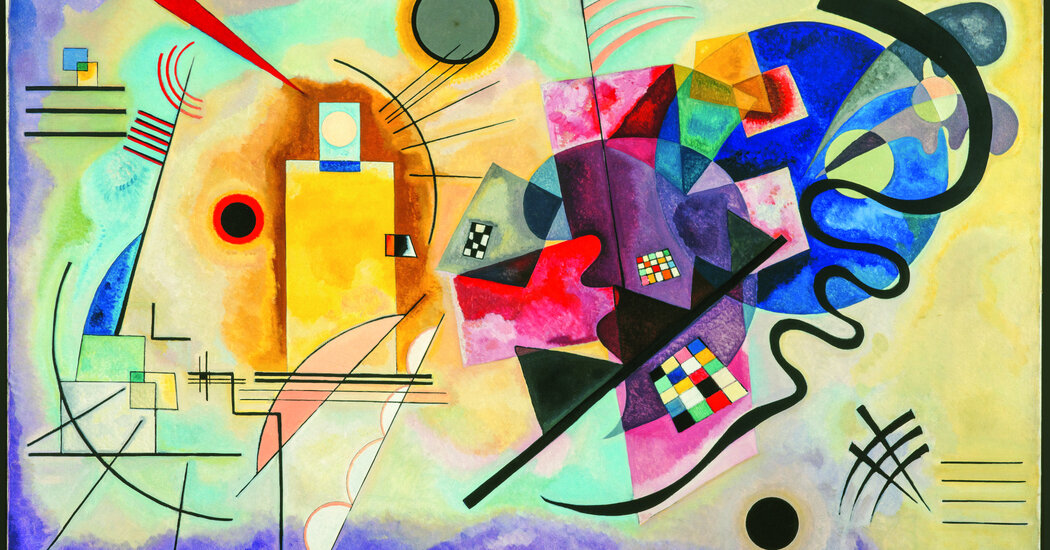In 1896, the 30-year-old Wassily Kandinsky attended a performance of Richard Wagner’s opera “Lohengrin” at the Bolshoi Theater in Moscow.
“In spirit I saw all my colors — they stood in front of my mind’s eye. Wild, almost mad lines, appeared before me,” the future artist said of that first encounter with Wagner’s romantic opera. “It became quite clear to me,” he continued, “painting could develop the same powers that music possessed.” That same year, he moved from his native Russia to Munich, determined to study painting.
Kandinsky’s life-changing, perception-altering encounter with “Lohengrin” is examined in the opening gallery of “Kandinsky. The Music of Colors,” an exhibition on view until Feb. 1, 2026, at the Philharmonie de Paris’s Musée de la Musique — across town from the Grand Palais, where Art Basel Paris will run from Friday to Sunday. Roughly three-quarters of the nearly 200 artworks and objects on display hail from the Pompidou Center in Paris, home to one of the world’s largest Kandinsky collections and a co-organizer of the exhibition.
The Pompidou’s glass and metal building is undergoing a major renovation currently projected to end in 2030. “The Music of Colors” is one of numerous exhibitions and events worldwide that the Pompidou is taking part in during that time.
It is also the latest installment in the Musée de la Musique’s series of shows dedicated to visual artists, including Paul Klee, Marc Chagall, Pablo Picasso and Jean-Michel Basquiat.
“I think the expertise of the Musée de la Musique lies in its ability to reflect on the links between music and the fine arts; it’s not just a question of biography or sensory parallels,” said Marie-Pauline Martin, director of the Musée de la Musique, who organized the show along with Angela Lampe, a curator of modern art at the Pompidou.
“We try to not repeat the same recipe for each project,” Martin added, explaining that research is always her starting point in crafting an “audiovisual identity that fits the subject.” An essential resource for “The Music of Colors” was Kandinsky’s archive at the Pompidou, donated by the artist’s second wife, Nina, which includes 95 shellac records that the couple owned.
Martin admitted that assembling the show on Kandinsky required a “much more intellectual, more sensitive, airier approach” than the museum’s Basquiat exhibition, which plunged visitors into the often abrasive sonic world of downtown New York in the late 1970s and early 1980s. In collaboration with the pianist Mikhail Rudy, who served as a musical adviser for “The Music of Colors,” Martin and Lampe assembled a soundtrack featuring music that was important to Kandinsky, quotations by the artist and an original sound design. Visitors wear geolocated headphones that automatically switch between tracks — for example, from the prelude to “Lohengrin” to a traditional Russian Orthodox chant — as they wander from room to room.
Twelve thematic sections reveal the extent to which music influenced Kandinsky’s theory and practice through works from every phase of the artist’s career. Many came into being before World War I, when he was part of the Blue Rider (Der Blaue Reiter) artists’ circle, centered in Munich, and in the interwar period, when he taught at the Bauhaus, an influential German art school. Both his increasingly bold chromatic experiments on canvas and his graphic attempts to represent musical scores show that his thinking about the relation between sound and image could be spiritual or analytic.
Few of the artworks on display illustrate specific musical pieces. One that does is “Impression III (Concert)” (1911), on loan from the Lenbachhaus museum in Munich. Kandinsky painted it as a synesthetic response to an Arnold Schoenberg concert he attended in Munich. The discovery of Schoenberg’s atonal compositions was a generative aesthetic shock on par with his earlier Wagner epiphany. On the program that evening was Schoenberg’s seminal String Quartet No. 2, Op. 10 (1907-8), whose first movement plays for museumgoers as they approach the painting, a riot of color formally arranged according to musical principles such as variations in rhythm and pitch.
“The particular destinies, the autonomous paths, the very lives of individual voices in your compositions are precisely what I have been looking for in pictorial form,” Kandinsky wrote to the composer after the concert.
The two became friends. In an essay that Schoenberg contributed to the famous “Blue Rider Almanac” (1912), also on view, he ranked Kandinsky among the few artists who “paint pictures in which the external object is hardly more to them than a stimulus to improvise in color and form.”
Twenty records on display from Kandinsky’s archive attest to an eclectic musical taste: The selection includes works by Bach and Stravinsky, Kurt Weill’s “Threepenny Opera,” “Kol Nidrei” and 1920s dance music. There is also a reconstruction of part of the set of the 1928 Dessau, Germany, staging of Modest Mussorgsky’s “Pictures at an Exhibition,” which was the only time Kandinsky directed and designed a production of a well-known piece of music.
Kandinsky often chose musical titles (including “Improvisation,” “Fugue” and “Song”) for his paintings, yet he reserved the name “Composition” for 10 of his most ambitious canvases. Lampe, the Pompidou curator, said it was telling that this was the name he chose for “very big, very important works in his oeuvre and for which he worked quite hard.”
“The Music of Colors” ends with the final three of these large-scale works: “Composition 8” (1923), which hails from the Guggenheim in New York; “Composition 9” (1936), from the Pompidou; and “Composition 10” (1939), on loan from the Kunstsammlung Nordrhein-Westfalen in Düsseldorf, Germany.
Lampe said that this rare grouping was intended as the climax of an exhibition that investigates how music provided the blueprint for Kandinsky to move art beyond figuration. “That was his intellectual model: music as an abstract art par excellence,” she said.
The post In Paris, a Kandinsky Exhibition That Lets You Hear the Paintings appeared first on New York Times.




